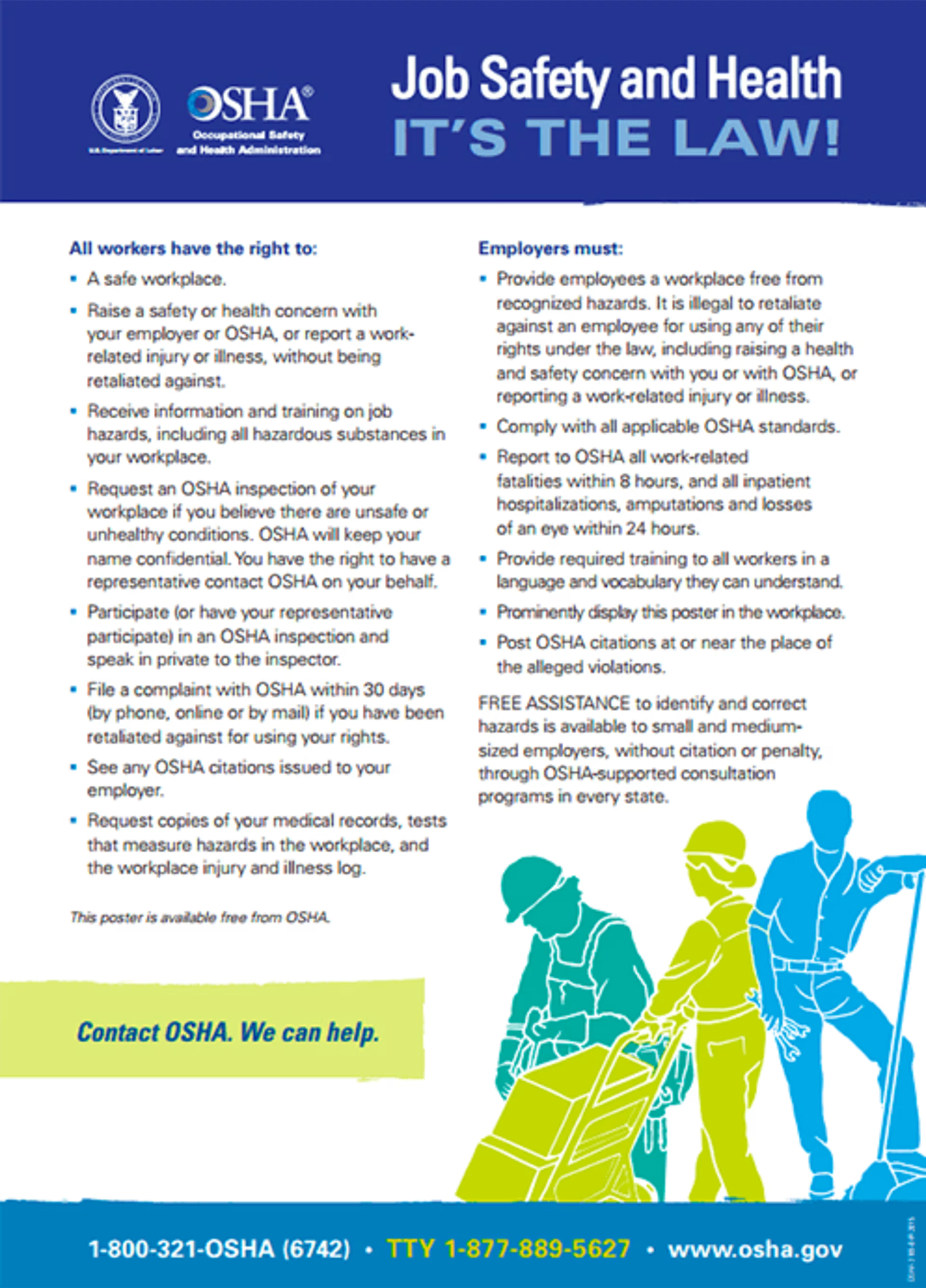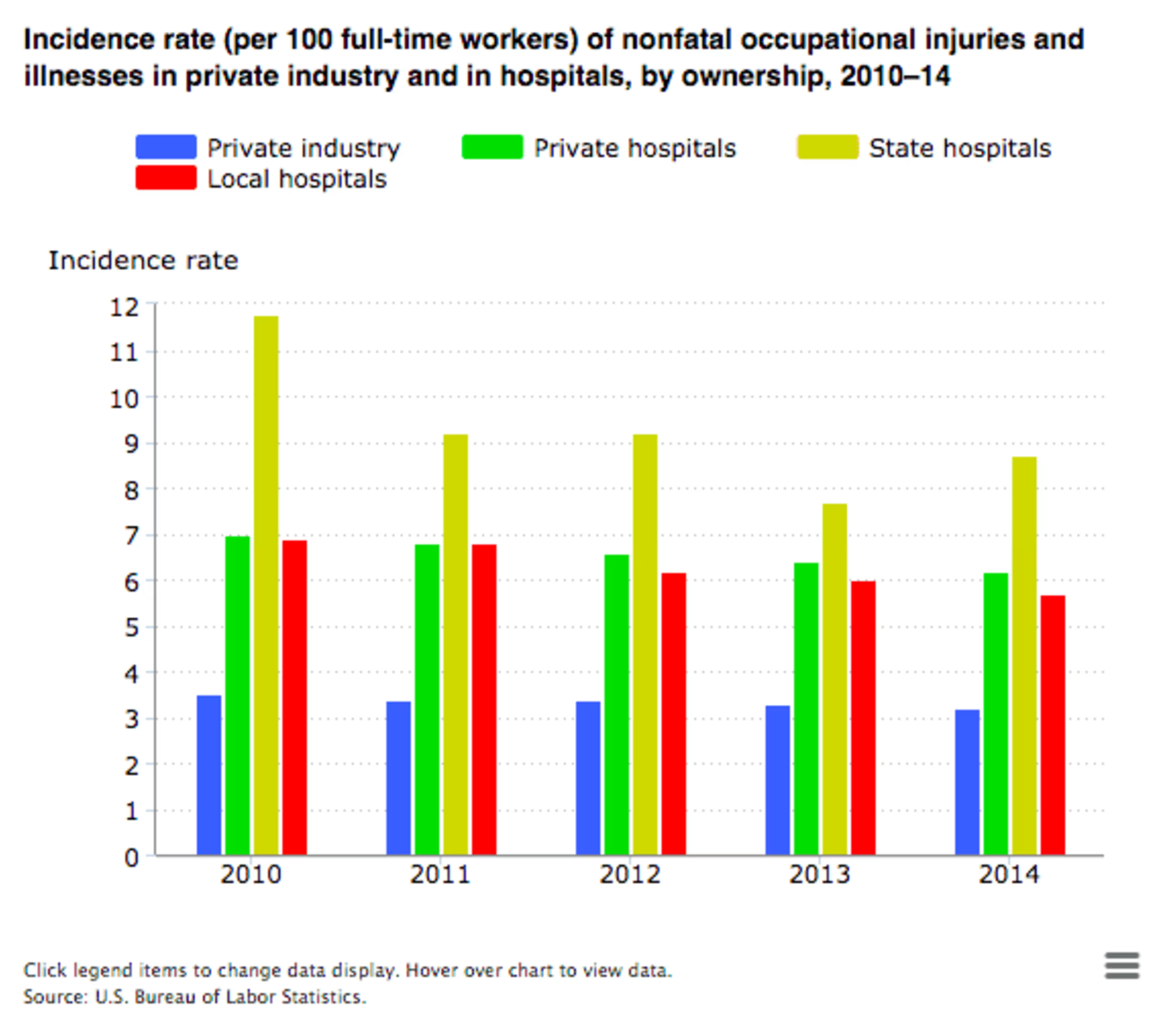You're aware of OSHA (Occupational Safety and Health Administration), whether you know it or not. You probably know them from seeing their attractive (and mandatory) posters around your office:

(Source: OSHA)
Or videos such as this one:
Here, we're taking a look at how OSHA got its start, how it impacts worker health and safety today, particularly workers in the healthcare field, and how you can improve safety in your hospital or healthcare environment.
A brief overview and history of OSHA
In 1969, 14,000 workers were dying each year from traumatic injury on the job, with thousands more getting hurt or sick.
President at the time, Richard Nixon, cited technological progress, describing it as a “mixed blessing," which had resulted in new products that improved consumers' lives, while at the same time causing “unpleasantness and pain" for workers.
In 1970, Nixon signed into law the first federal program aimed at preventing job-related death, injury, and illness for the entire American workforce.
That law, the Occupational Safety and Health Act, spawned the creation of a new agency, the Occupational Safety and Health Administration, or OSHA.
Today, OSHA's 2,100 inspectors (including state partners) monitor 130 million workers at 7 million workplaces.
A few quick facts about OSHA:
The first five industries targeted by OSHA for safety hazards were marine cargo handling, roofing and sheet metal work, meat and meat products, miscellaneous transportation equipment (primarily mobile homes), and lumber and wood products
OSHA's first computer system ran on 1 MB of RAM with 40 MB of storage
Since OSHA's inception, average daily workplace deaths have dropped by more than half
OSHA's impact on healthcare workers
According to the Houston Chronicle, the healthcare industry has more workplace-related illnesses and injuries than any other industry. Hospital workers in the U.S. sustained an estimated 294,000 nonfatal work-related injuries and illnesses in 2014.
In 2010, when you combine the healthcare and social assistance industries, there were 653,900 reported cases of injury and illness, more than any other private sector industry. That's 152,000 more cases than the next most dangerous industry, manufacturing.

Employer-reported hospital workplace injuries and illnesses(Source: U.S. Bureau of Labor and Statistic)
Why focus on healthcare worker safety, besides keeping your employees safe? According to OSHA, “patient and worker safety often go hand-in-hand."
In 1999, the Institute of Medicine (IOM) released a public health report which finds that a healthcare delivery organization, or HDO's foundational cultural, procedural, and systemic choices impact both patient and worker safety.
OSHA points to several studies that find that choices made by HDOs are “the most significant predictor of safe work behaviors."
In other words, healthcare workers will make safer, better choices when they:
Believe leadership cares about their safety
Are in the right frame of mind and emotional state
Have proper, comprehensive training
And, having all of these things in place will ultimately improve patient safety as well.
Improving healthcare safety across the board
A crucial key to healthcare worker safety, then, is creating a "culture of safety" through rules, norms, rewards, and training.
To achieve this, one of the first things you should do is create a process for recording the types, locations, and underlying reasons for workplace injuries and illnesses in your HDO.
OSHA has a handy tool for this purpose, called the employer's OSHA 300 log. OSHA recommends thoroughly reviewing and carefully analyzing your 300 log so you can use what you learn to create a roadmap toward injury and illness prevention.
Here are three tips for creating a safety culture for patients and workers in a healthcare context.
1. Take responsibility at all levels
Good management is key to both patient and worker safety. According to OSHA: “Strong and visible management leadership is perhaps the most critical element of a safety and health management system."
Strong and visible leadership can take many forms, from frequent in-person communication between leadership and workers to leaders setting an example for workers by following protocol themselves. But the most important aspect is to establish responsibility. Make it clear that the buck stops here, at leadership, when it comes to safety.
2. Encourage worker participation
In 2010, according to OSHA, nursing aides, orderlies, and attendants had the highest rates of musculoskeletal disorders of all occupations. That year, the average rate of work-related musculoskeletal disorders for workers across all industries was 34 per 10,000 workers, while the incidence rate of for healthcare occupations was 249.
To avoid chronic issues such as these, OSHA strongly urges healthcare organization to get workers involved in safety planning. According to OSHA, “When workers are encouraged to offer their ideas, and they see their contributions being taken seriously, they tend to be more satisfied and more productive."
Ask your employees how the existing processes and procedures in the workplace impact their mental and physical well-being. For example, if nurses are straining their backs lifting heavy patients, the solution could be as simple as introducing a change in bed height or a device to help with lifting.
3. Keep equipment and training up to date
Hazard identification, assessment, prevention, and control must be high priority. Make sure healthcare workers have easy access to high quality, setting-appropriate, protective equipment.
Foster a culture of safety by establishing and reinforcing group norms around acceptable safety practices. Several hospital-based studies, according to the CDC's Healthcare Infection Control Practices Advisory Committee, have shown a link between a well established safety culture and how closely employee adhere to safe blood and body fluids handling practices.
Teach and train all staff in best-in-class safety procedures and practices. Make sure this training is regularly updated and ongoing, not just carried out for new staff members.
Also make sure you're constantly evaluating, innovating, and improving your equipment, processes, and training.
Conclusions
Research shows that creating a safety culture has tons of benefits including:
Reducing employee injuries, illnesses, and fatalities
Lowering workers' compensation and related costs
Improving morale and communication
Enhancing an HDO's image and reputation
Helping HDOs innovate more effective, efficient processes, products, and services
HDOs that implement safety and health management systems dramatically decrease their workplace injuries. They also often report higher productivity and quality, reduced turnover, reduced costs, and greater employee satisfaction.
What other tips do you have for making healthcare workplaces safer for patients and workers? Let me know in the comments below.
And to learn more about OSHA and compliance, check out these posts from our healthcare technology blog:
5 Ways To Crush OSHA Fines With A CMMS
Construction Health and Safety: OSHA Rules You Can't Afford to Ignore
How To Avoid an OSHA Audit in Your Construction Business
Does your Business Meet Compliance? 5 Top V-Comply Alternatives Compared